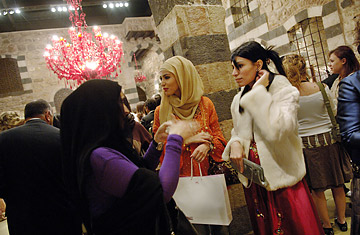
Guests gather around for the opening party for luxury boutique Villa Moda's branch in Damascus.
(2 of 3)
"I understand the girls you saw," Nayla Yared, project manager of Dubai International Fashion Week, comments later. "It's really tough for them. They are still wearing the abaya, but they are exposed to all these Western influences by satellite TV and Internet, and they are trying to find a way out."
They sound like designer Rabia Zargarpur's target clients. Her new label, Rabia Z., is dedicated to conservative ready-to-wear and features separates that cover the arms and fit loosely around the hips. She received so much attention during fashion week that she says she can't believe the larger fashion chains are ignoring this segment. "The young generation wants to wear the hijab and be trendy too," says Zargarpur, 31, who studied fashion and business in the U.S. Her goal is to meet the standards of modesty, no abaya needed. Criticism from some older wearers of the niqab—the veil favored by conservatives that covers everything but the eyes—has been harsh. "One of them said, 'This is wrong,' but you know, she's not my target—she's not struggling. I admire her, but frankly, not all of us have that level of faith," Zargarpur says. "But on the other hand, I have failed my client if a woman wearing my clothes was called a muhajababe."
That's the title of a recent book on the "sexy, devout" Middle East youth culture by English journalist Allegra Stratton. A twist on muhajabah (one who veils), the term refers to girls who pair black hipster pants and stilettos with black sheer head scarves wrapped tight. For some, covering up becomes a pure act of fashion. "The friends of ours that are veiling are doing it because a tight head scarf and a tight outfit is a good look, they think," a Jordanian girl tells Stratton.
That ambiguity ignites Internet chat rooms and riles grannies. They're unnerved by the way fashion is scrambling the signals of dress, blurring the distinctions between those who cover their body and head for religious reasons and everyone else. And it's not just the muhajababes. The plain black abaya accessorized with gaudy logo sunglasses and flashy jewelry also draws flak. It seems silly to correlate bling wattage and spirituality, but change the context and imagine the Amish adding diamanté trims to their brown, wool, buttonless dresses. What would be the point? That unease spills over into media and advertising. Even the normally freewheeling mtv executives praised—and laughed at—agency ideas for commercials that focused on dress, but they ultimately rejected them. One mixed traditional dress with an Abba Dancing Queen sound track, and another scenario smiled at the way Saudi girls slip in and out of their abayas on takeoff and touchdown when flying abroad. Both ads were deemed too risqué.
From customization it's just a baby step to more radical challenges to the rules, especially for trendsetters in countries like Saudi Arabia, where Islamic dress codes are strictly enforced. In most parts of the world, fashion's capacity for revolution seems spent, but in the Middle East, fashion looks like a subtle but powerful tool for rebels and reformers trying to provoke the Establishment and connect with a younger generation. In the cosmopolitan Saudi Arabian port city of Jidda, the girls have taken to letting their cowl scarves rest on their shoulders, tugging them into place over their head only if they feel harassed by men. Or skipping the traditional scarves altogether. Local designer Sarah Bin Hejaila proposes a perky alternative—a newsboy cap tricked out with a printed bandanna. At the cafés near the medical school, female students substitute their white lab coats—unbuttoned—for the black robes. In Iran, the authorities keep an eye on the trends; in December, the Tehran police chief announced he was cracking down on "tight trousers tucked inside long boots while wearing short overcoats," which he said violated Islamic rules.
As always in this region, it's simpler for the guys. Lomar was launched six years ago by a husband-and-wife team, Loai Nassem and Mona al-Haddad, who started with a few designs produced by a tailor working out of their house in Jidda. Along with their partners Eissa Bougary and Marwan Qutub of the 3 Points ad agency, they noticed that the younger generation was ditching the thobe (traditionally favored by 90% of Saudi males, Bougary said) and choosing Nike and Puma instead. "If you do not provide young people with a local solution that fits their lifestyle, they will buy Western clothes," says Bougary. The loose-fitting thobe has survived because it's better suited to the hot desert climate than clingy European and American designs. It's also easier, he argues, because there are no shirts, belts, ties or socks to coordinate.